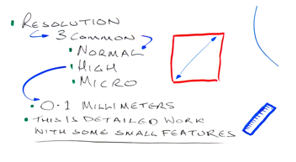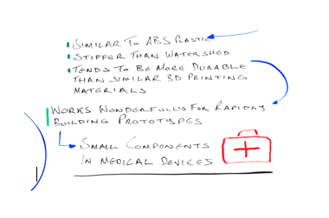
Fine Detail – 3D Printing Fine Resolution Features
Your masterclass in product design and development
Protolabs’ Insight video series
Our Insight video series will help you master digital manufacturing.
Every Friday we’ll post a new video – each one giving you a deeper Insight into how to design better parts. We’ll cover specific topics such as choosing the right 3D printing material, optimising your design for CNC machining, surface finishes for moulded parts, and much more besides.
So join us and don’t miss out.
Insight: Fine Detail – 3D Printing Fine Resolution Features
Hi and welcome to this week’s Insight video for Friday.
As a reminder, we pop another one of these videos up every Friday lunchtime. They’re all full of useful facts around digital manufacturing, and we’re hoping they’ll help to clear up some myths, show off some innovative pieces of kit and – with a bit of luck – save you some time and some money.
Right, with that out of the way let’s get started on this week’s topic – 3D printing fine detail features.
When we – or any other producer – create parts it’s pretty important that we get the little details correct. We need to make sure that when we print them, this element of the part is precisely here, and is exactly this wide and this deep.

Ensuring this is all right depends on the resolution of the machine producing the part. This idea of resolution should be one we’re all pretty familiar with these days – after all, the quality of the video you’re watching right now depends on the resolution. If we turn that resolution down, we lose the ability to see the details.
Now, just like with screens and videos, it would be easy to assume that this is a situation where higher means better, but when it comes to 3D printing the most efficient way to work is to size the resolution so that it’s appropriate to the task at hand. For this reason, it’s common to work in three different resolutions: normal, high and micro.
Now, most parts people are looking to print work just fine with a normal resolution. This is your standard print, without the need for incredibly detailed features.
As the precision of the design increases, we move over to high resolution. At this level we’re talking about features on the scale of about 0.1 millimetres. This is detailed work, with some pretty small features.

But what if that’s not enough? What if that’s not precise enough?
When you need things to be very fine – and we’re talking parts with features measuring in the hundredths of millimetres – it’s time switch to the micro resolution.
However, when you’re working on this kind of scale you need to think long and hard about the material you’re using. Most of the time a standard plastic won’t quite be able to keep the level of detail high enough, and even if it can we risk losing rigidity.
For example, here at Protolabs we turn to MicroFine Green – a material that’s specially designed for handling these kinds of precision jobs. When we build materials with it, the individual layers come out at just 0.025mm thick. That really is very, very small, and can allow for some incredibly tight tolerances.

As the name implies, MicroFine Green is bright green in colour, and its mechanical properties make it fairly durable and rigid. Among common plastics it’s most similar to an ABS plastic. It’s stiffer than Watershed—a clear, microfluidic material— and features built using it tend to be more durable than similar 3D printing materials working on that kind of scale.
Having said that, the nature of the material – and of most materials used at the microfine level –aren’t usually durable enough for end-use applications. Basically, you probably aren’t building your finished product out of this. Instead, what it works wonderfully for is rapidly building prototypes that require this level of detail.
At the moment, most of the companies and developers we’ve seen working with these materials are using them to quickly and reliably prototype small components in medical devices. As you can probably guess, this is an area where getting the little details right is really very important, so we need to make sure the resolution is as high as possible.

Oh, and one more difference between these types of plastics and more conventional prints is the finish. If the parts we’re working on have a standard finish, we’d usually grit blast the part to ensure it’s nice and smooth.
When it comes to micro-resolution parts, we tend to skip that particular step, because the sand blasting process isn’t particularly good for preserving tiny details. Which makes sense, when you think about it.
So the next time you’re thinking of designing a part that requites incredible precision, make sure it looks good in green.
In the meantime, have a great weekend and I look forward to sharing our next Insight video with you next Friday.
Until next week.
With special thanks to Natalie Constable.











